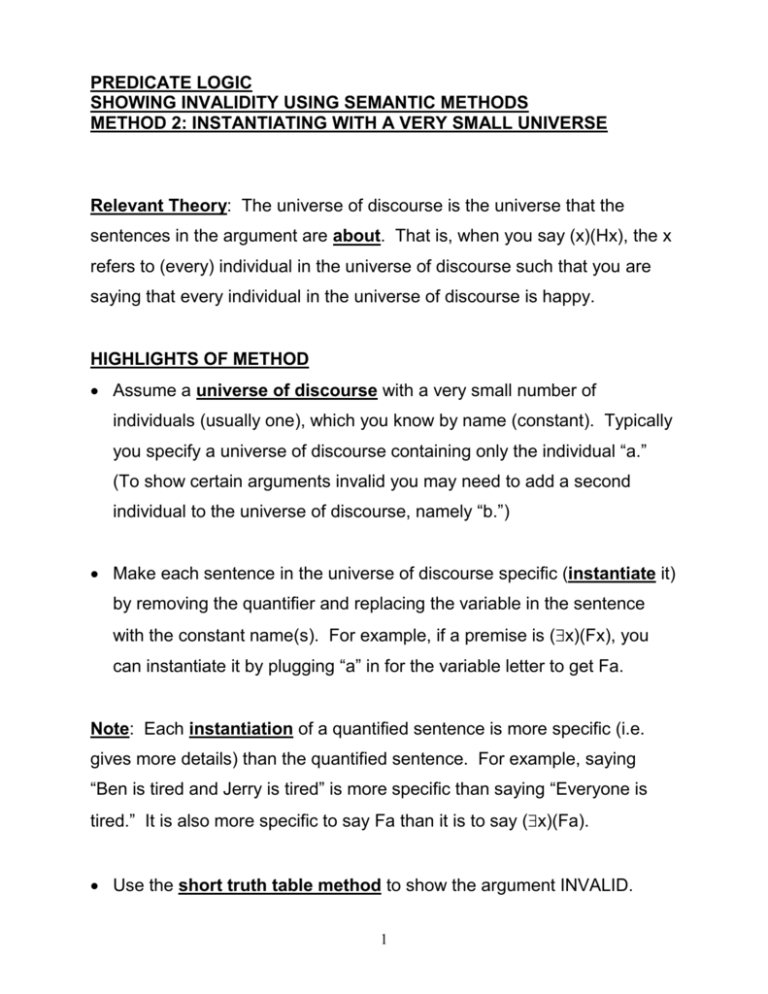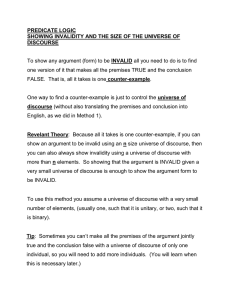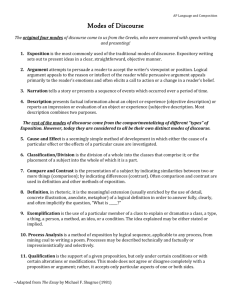Method 2: Showing Invalidity Using Instantiation
advertisement

PREDICATE LOGIC SHOWING INVALIDITY USING SEMANTIC METHODS METHOD 2: INSTANTIATING WITH A VERY SMALL UNIVERSE Relevant Theory: The universe of discourse is the universe that the sentences in the argument are about. That is, when you say (x)(Hx), the x refers to (every) individual in the universe of discourse such that you are saying that every individual in the universe of discourse is happy. HIGHLIGHTS OF METHOD Assume a universe of discourse with a very small number of individuals (usually one), which you know by name (constant). Typically you specify a universe of discourse containing only the individual “a.” (To show certain arguments invalid you may need to add a second individual to the universe of discourse, namely “b.”) Make each sentence in the universe of discourse specific (instantiate it) by removing the quantifier and replacing the variable in the sentence with the constant name(s). For example, if a premise is (x)(Fx), you can instantiate it by plugging “a” in for the variable letter to get Fa. Note: Each instantiation of a quantified sentence is more specific (i.e. gives more details) than the quantified sentence. For example, saying “Ben is tired and Jerry is tired” is more specific than saying “Everyone is tired.” It is also more specific to say Fa than it is to say (x)(Fa). Use the short truth table method to show the argument INVALID. 1 METHOD 2: Showing Invalidity Using Instantiation & Short Truth Table Example 1: (x)(Fx Gx) (x)(Gx & Hx) (x)(Fx & Hx) 1. Assume a very small universe of discourse (one or two elements). Tip: Sometimes you can’t make all the premises of the argument jointly true if you have a universe of discourse of one individual, so you will need to add another constant name (covered later). 2. Assign a constant to each individual in the universe of discourse (a). Tip: If the argument you are evaluating contains a constant name, the individual named by that name has to be in the universe of discourse. For example, if an argument contains the constant name “a,” the individual referred to by “a” has to be in the universe of discourse you use to evaluated the argument. universe of discourse: a 3. Instantiate each sentence in the argument (premises and conclusion) by removing the quantifier and plugging in the constant name for each variable. 2 Tip: If your universe of discourse is greater than one, to instantiate each sentence you will need to create truth functional expansions (with “a” and “b”) appropriate to (1) universally quantified statements and (2) existentially quantified premises. (You will learn this in the next section.) Example: Instantiated: (x)(Fx Gx) Fa Ga (x)(Gx & Hx) Ga & Ha (x)(Fx & Hx) Fa & Ha 4. Create a truth table with column headings such that the conclusion is on the far right, the premises to the immediate left of the conclusion, and the atomic (singular) sentence components to the far left. Fa Ga Ha Premise 1 Premise 2 Conclusion Fa Ga Ga & Ha Fa & Ha 5. Write an “F” under the conclusion to make it false. 6. Try to assign the truth values to the component sentences in such a way as to make the conclusion false and the premises true. Premise 1 Premise 2 Conclusion Fa Ga Ha Fa Ga Ga & Ha Fa & Ha F T T T T F 3 Guidance for Example: There are three ways to make the conclusion false (Fa and Ha both false, Fa false and Ha true, or Fa true and Ha false). But, to make Premise 2 true, both conjuncts have to be true, so you have to make both Ga and Ha true. If Ha is true, the only way to make the conclusion false is to make Fa false. If Fa is false, Premise 1 is true. Relevant Theory: If you can make all the premises TRUE by adjusting the truth values of the component parts, you have shown the particular instantiation of the argument to be INVALID. This makes the argument form INVALID. 7. Check to see whether all the premises TRUE and the conclusion is FALSE. If so, you have shown the particular instantiation of the argument and the argument form to be INVALID. If this is impossible, you have shown the argument form to be VALID. Example 2: Argument Form Instantiated Argument (x)(Fx & Gx) Fa & Ga (x)(Hx) Ha (x)(Fx ~Hx) Fa ~Ha Fa Ga Ha Premise 1 Premise 2 Conclusion Fa Ga Ga & Ha Fa ~Ha F Result: 4








